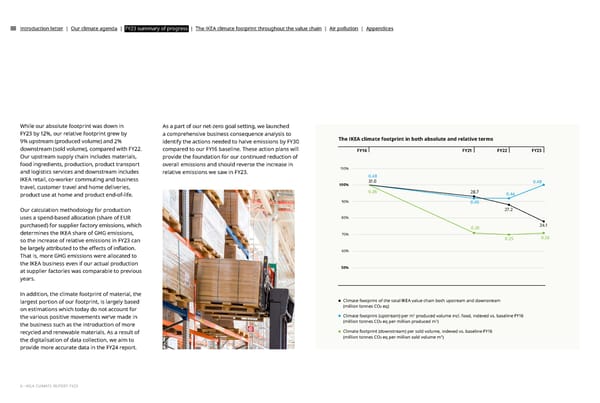Introduction letter | Our climate agenda | FY23 summary of progress | The IKEA climate footprint throughout the value chain | Air pollution | Appendices While our absolute footprint was down in As a part of our net-zero goal setting, we launched FY23 by 12%, our relative footprint grew by a comprehensive business consequence analysis to The IKEA climate footprint in both absolute and relative terms 9% upstream (produced volume) and 2% identify the actions needed to halve emissions by FY30 downstream (sold volume), compared with FY22. compared to our FY16 baseline. These action plans will FY16 FY21 FY22 FY23 Our upstream supply chain includes materials, provide the foundation for our continued reduction of food ingredients, production, product transport overall emissions and should reverse the increase in and logistics services and downstream includes relative emissions we saw in FY23. 110% IKEA retail, co-worker commuting and business 0.48 100% 31.0 0.48 travel, customer travel and home deliveries, 0.36 product use at home and product end-of-life. 28.7 0.44 90% 0.45 Our calculation methodology for production 27.2 80% uses a spend-based allocation (share of EUR 24.1 purchased) for supplier factory emissions, which 0.26 determines the IKEA share of GHG emissions, 70% so the increase of relative emissions in FY23 can 0.25 0.26 be largely attributed to the e昀昀ects of in昀氀ation. 60% That is, more GHG emissions were allocated to the IKEA business even if our actual production 50% at supplier factories was comparable to previous years. In addition, the climate footprint of material, the largest portion of our footprint, is largely based Climate footprint of the total IKEA value chain both upstream and downstream on estimations which today do not account for (million tonnes CO2 eq) 3 the various positive movements we've made in Climate footprint (upstream) per m produced volume incl. food, indexed vs. baseline FY16 3 the business such as the introduction of more (million tonnes CO2 eq per million produced m ) recycled and renewable materials. As a result of Climate footprint (downstream) per sold volume, indexed vs. baseline FY16 3 (million tonnes CO2 eq per million sold volume m the digitalisation of data collection, we aim to ) provide more accurate data in the FY24 report. 6 - IKEA CLIMATE REPORT FY23
 IKEA CLIMATE Report FY23 Page 5 Page 7
IKEA CLIMATE Report FY23 Page 5 Page 7